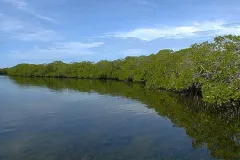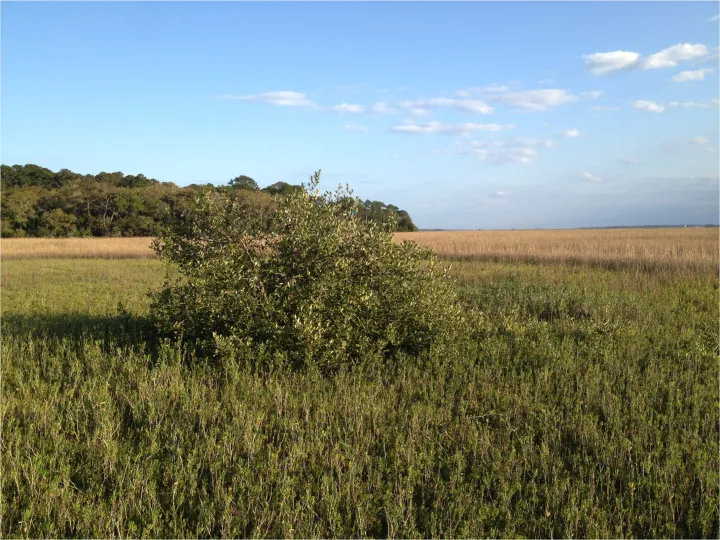Mangrove Restoration: Letting Mother Nature Do The Work

The ecological importance of coastal mangrove forests is common knowledge today. The trees’ gnarled roots , submerged in saltwater for part of the day, make ideal underwater perches for barnacles, oysters, crabs and other marine organisms. These, in turn, make a plentiful feast for juvenile fish, as well as birds, reptiles and an abundance of other wildlife both above and below the water’s surface.
However, this is a relatively new notion. “Mangroves prior to 1970 were generally considered to be mosquito-infested swamps that nobody needed really to worry about, and if you wanted to destroy them, that was okay,” says Robin Lewis, an ichthyologist-turned-wetland scientist who now restores mangroves around the world.
Unfortunately, a better understanding of mangroves’ importance hasn’t stopped their destruction. Nearly 14,000 square miles of mangrove forests were destroyed between 1980 and 2005, according to the United Nations, and the losses continue today. (Less than 60,000 square miles remained in 2005.) People harvest the trees for timber, and pour dirt into the swampy habitat to reduce mosquito populations, build fish and shrimp farms, and create solid land for construction.
To make up for this loss, people attempt to restore mangroves all around the world. In most cases, they approach mangrove restoration as if they were planting a forest on land. They grow mangrove seedlings in greenhouses and then transplant them into mudflats along the ocean’s edge. The problem is that this approach doesn’t work very well. In the Philippines, for instance, the World Bank spent $35 million to plant nearly 3 million mangrove seedlings in the Central Visayas between 1984 and 1992. But by 1996, less than 20 percent of those mangroves had survived.
“We don’t know the exact percentage, but most of the mangrove restoration projects around the world that are attempted are not successful,” Lewis says. Wetland habitats (like mangroves) are more dynamic than terrestrial habitats; they’re submerged in water for part of each day as the tides come in and roll out. If the water level isn’t just right, the seedlings don’t stand a chance at survival.
Furthermore, plantings typically use only a single species of mangrove, even though most mangrove forests include many species. “Mangrove forests, like many forests, are composed of a mixture of trees and other communities. They are very complex,” says Lewis. “This supports a lot of wildlife and it is the healthy forest that we all talk about.” On the rare occasion when a single-species planting does take root, the resulting habitat is less complex and supports fewer species.
Over the past 40 years, Lewis has pioneered a different method of mangrove restoration that works far better. In fact, he’s established mangrove forests in more than 20 countries around the world. The method — which he calls ecological mangrove restoration — is more difficult and less photogenic than planting pretty rows of seedlings. But it may be our best shot at bringing back the world’s mangroves.
Water Works
Lewis figured out how to restore mangroves by immersing himself in them, literally. “I spent a decade working in the mangroves before I started to have an understanding of what was going on,” he says. He started out by observing healthy mangroves around Tampa Bay as a graduate student in the late 1960s. He noticed that whenever a mangrove tree died, mangrove seeds floating in the water arrived and took root in no time. The mangroves didn’t need his help to grow back; the area recovered all by itself.
It seemed to Lewis that mangrove forests could and would restore themselves if the conditions were right; he just had to identify the ‘right conditions.’ Soil nutrients didn’t seem to matter, as mangroves can transform sand into rich mangrove peat in a few years. Floating seeds were ubiquitous as long as healthy mangroves lived nearby, so that wasn’t the problem either. But the flow of water (known as hydrology) onto the soil made all the difference in the world.
Mangroves live on the edge of the ocean, and so their roots have to endure wetness (when the tide comes in) and dryness (when the tide goes out). In Tampa Bay, Lewis observed that most mangroves do best when their roots were wet about 30 percent of the time, and dry for the remaining 70 percent of the time. Each of the area’s three species of mangrove tree preferred slightly different conditions, but they were all right around that 30/70 wet-to-dry ratio. “They have a short period of wetness, and then they have a long extended period of dryness, and those alternate daily,” he says. “That’s the secret: You’ve got to replicate that hydrology.”
Let The Tide Roll In
In 1986, Lewis had an opportunity to test his idea when he was hired to restore 1,300 acres of mangroves at West Lake Park near Ft. Lauderdale, Florida. Around 200 acres of the mangroves were completely dead; dirt piled high over the dead trunks and branches, and invasive plants grew wild. Throughout the site, ditches pooled standing water and dirt piles blocked the tides. He knew that if he wanted floating seeds to naturally restore the area, he’d have to fix the water flow.
So he started by again immersing himself in the mangroves. Lewis hired a hydrologist to map the area’s water movement while he experimented with restoration on a small ten-acre plot. After three years, he had enough information to get started on the full restoration project. Largely that involved one difficult task: “We had to move a lot of dirt,” Lewis says. Using bulldozers and backhoes, Lewis and a team of engineers moved piles of dirt away from the site. Then, they constructed a slight slope leading down into the ocean so that tides could easily flow.
By 1989, West Lake Park didn’t look like a mangrove forest at all; it looked like a dirt area riddled with small channels of water. But he didn’t have to wait long for the mangrove seeds to arrive and take root. By 1991, mangrove seedlings had sprouted all along the shore. By 1996, all three of Florida’s mangrove species had established at West Lake. Adult and juvenile fish soon moved in; a survey found as many fish and species at West Lake as at an older, healthy mangrove site nearby. And those fish attracted shorebirds and wading birds.
“There wasn’t a single mangrove planted in the whole project,” says Lewis. “Mother Nature can do such a great job of repairing herself if you give her the opportunity.”
Since then, Lewis’s ecological restoration methods have been used to restore 30 mangrove sites in the United States, along with mangroves in another 25 countries around the world. In Thailand, Indonesia and other countries, local communities dependent on mangroves have learned his methods, too.
It’s difficult work, far more difficult than planting a pretty row of seedlings. It takes planning, intense study, and patience. But it works. And it’s what’s needed to restore the world’s mangroves, says Lewis.
“It’s not at all unreasonable to think about increasing the amount of mangroves. Even with sea level rise, we could actually stop the loss and we could actually increase,” he says. “So we really need to get to work.”
This story was made possible by a grant from the Smithsonian Women's Committee. http://swc.si.edu/about-grants


